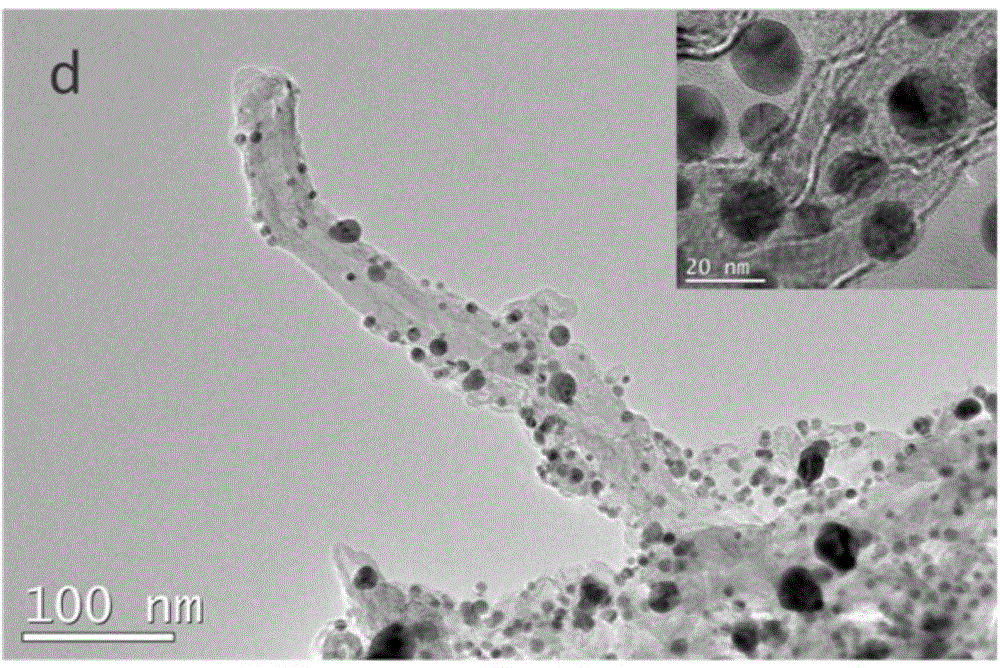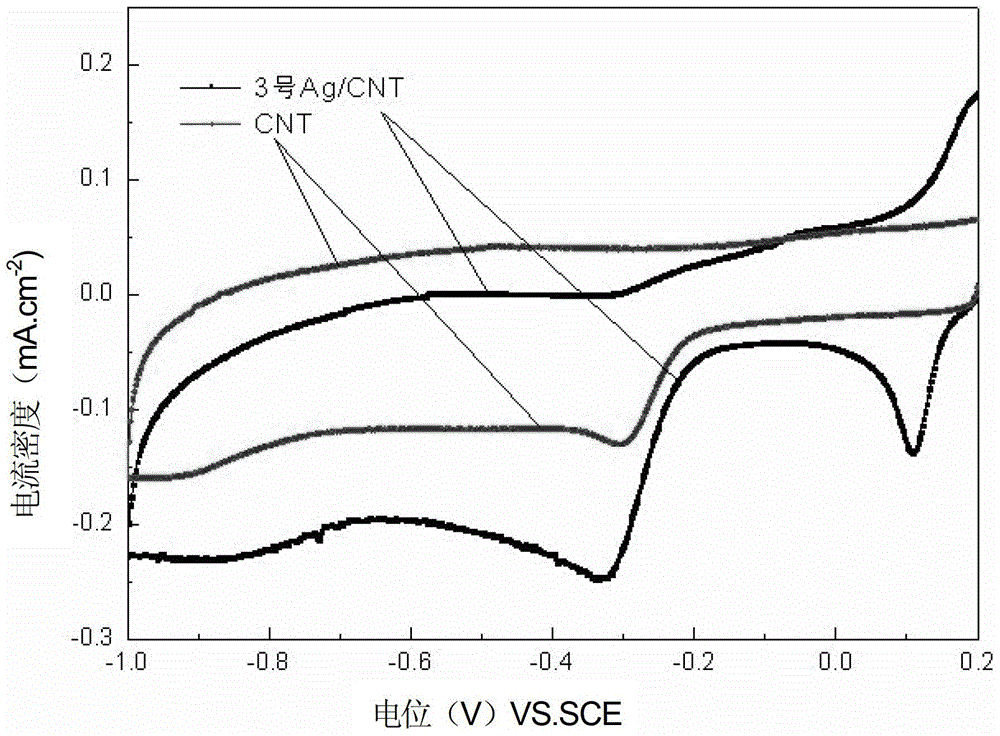Oxygen reduction catalyst for zinc-air battery and preparation method thereof
A zinc-air battery and catalyst technology, applied in battery electrodes, circuits, electrical components, etc., can solve the problems of easy aggregation, poor stability, and easy corrosion of nano-Ag particles, and achieve superior electrochemical performance and uniform particle size Effect
- Summary
- Abstract
- Description
- Claims
- Application Information
AI Technical Summary
Problems solved by technology
Method used
Image
Examples
Embodiment 1
[0033]To prepare an Ag / CNT catalyst with an Ag content of 5wt%, firstly take a certain amount of CNT and disperse it into a mixed acid solution of 100ml of concentrated sulfuric acid (98wt%) and 33ml of concentrated nitric acid (65wt%), then magnetically stir for 6 hours at room temperature, and use a vacuum pump Suction filtration, repeated washing with deionized water and absolute ethanol, and dry the filter cake in a vacuum drying oven at 80°C for 12 hours when the filtrate is neutral. Take 160mg of the above-mentioned treated CNT, disperse it into 100ml of deionized water, and ultrasonicate for 30min to obtain a CNT solution; then take 13.8mg of silver nitrate and dissolve it in 20ml of deionized water, and take 0.119g of sodium citrate dihydrate solution into 15ml of deionized water , the silver nitrate solution, the sodium citrate dihydrate solution and the CNT solution were mixed and stirred for 20 minutes, and then the mixed solution was put into an ice-water bath and s...
Embodiment 2
[0035] To prepare an Ag / CNT catalyst with an Ag content of 10wt%, first take a certain amount of CNT and disperse it into a mixed acid solution of 100ml of concentrated sulfuric acid (98wt%) and 33ml of concentrated nitric acid (65wt%), then magnetically stir for 6 hours at room temperature, and use a vacuum pump Suction filtration, repeated washing with deionized water and absolute ethanol, and dry the filter cake in a vacuum drying oven at 80°C for 12 hours when the filtrate is neutral. Take 160 mg of the above-mentioned treated CNT, disperse it into 100 ml of deionized water, and ultrasonicate for 30 minutes to obtain a CNT solution; then take 28.0 mg of silver nitrate and dissolve it in 20 ml of deionized water, and at the same time, take 0.242 g of sodium citrate dihydrate solution into 20 ml of deionized water , the silver nitrate solution, the sodium citrate dihydrate solution and the CNT solution were mixed and stirred for 30 minutes, and then the mixed solution was put...
Embodiment 3
[0037] To prepare an Ag / CNT catalyst with an Ag content of 15wt%, firstly take a certain amount of CNT and disperse it into a mixed acid solution of 100ml of concentrated sulfuric acid (98wt%) and 33ml of concentrated nitric acid (65wt%), then magnetically stir for 6 hours at room temperature, and use a vacuum pump Suction filtration, repeated washing with deionized water and absolute ethanol, and dry the filter cake in a vacuum drying oven at 80°C for 12 hours when the filtrate is neutral. Take 160mg of the above-mentioned treated CNT, disperse it into 100ml of deionized water, and ultrasonicate for 30min to obtain a CNT solution; then take 44.4mg of silver nitrate and dissolve it in 25ml of deionized water, and at the same time take 0.355g of sodium citrate dihydrate solution into 25ml of deionized water , after mixing and stirring the silver nitrate solution, the sodium citrate dihydrate solution and the CNT solution for 40 minutes, put the mixed solution into an ice-water b...
PUM
| Property | Measurement | Unit |
|---|---|---|
| Particle size | aaaaa | aaaaa |
| Specific surface area | aaaaa | aaaaa |
| Average size | aaaaa | aaaaa |
Abstract
Description
Claims
Application Information
 Login to View More
Login to View More - R&D
- Intellectual Property
- Life Sciences
- Materials
- Tech Scout
- Unparalleled Data Quality
- Higher Quality Content
- 60% Fewer Hallucinations
Browse by: Latest US Patents, China's latest patents, Technical Efficacy Thesaurus, Application Domain, Technology Topic, Popular Technical Reports.
© 2025 PatSnap. All rights reserved.Legal|Privacy policy|Modern Slavery Act Transparency Statement|Sitemap|About US| Contact US: help@patsnap.com



